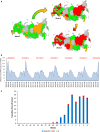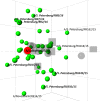Rapid spread of influenza A(H1N1)pdm09 viruses with a new set of specific mutations in the internal genes in the beginning of 2015/2016 epidemic season in Moscow and Saint Petersburg (Russian Federation)
- PMID: 26992820
- PMCID: PMC4910175
- DOI: 10.1111/irv.12389
Rapid spread of influenza A(H1N1)pdm09 viruses with a new set of specific mutations in the internal genes in the beginning of 2015/2016 epidemic season in Moscow and Saint Petersburg (Russian Federation)
Abstract
A dramatic increase of influenza activity in Russia since week 3 of 2016 significantly differs from previous seasons in terms of the incidence of influenza and acute respiratory infection (ARI) and in number of lethal cases. We performed antigenic analysis of 108 and whole-genome sequencing of 77 influenza A(H1N1)pdm09 viruses from Moscow and Saint Petersburg. Most of the viruses were antigenically related to the vaccine strain. Whole-genome analysis revealed a composition of specific mutations in the internal genes (D2E and M83I in NEP, E125D in NS1, M105T in NP, Q208K in M1, and N204S in PA-X) that probably emerged before the beginning of 2015/2016 epidemic season.
Keywords: A(H1N1)pdm09; Russia; high-throughput nucleotide sequencing; influenza.
© 2016 The Authors. Influenza and Other Respiratory Viruses Published by John Wiley & Sons Ltd.
Figures





References
-
- Danilenko DM, Konovalova NI, Prokopetz AV, Bildanova ER, Eropkin MY, Sominina AA. Potential use of rat polyclonal antisera in antigenic analysis of human influenza viruses. Epidemiology and Vaccinoprophylaxis 2013; 68:73–79. (in Russian).
-
- Smith D, Lapedes A, Jong J et al Mapping the antigenic and genetic evolution of influenza virus. Science 2004; 35:371–376. - PubMed
Publication types
MeSH terms
Substances
Grants and funding
LinkOut - more resources
Full Text Sources
Other Literature Sources
Medical
Miscellaneous

